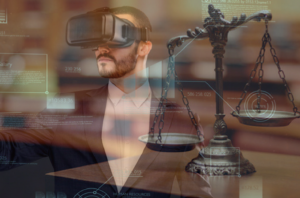22 January 2019 (Lille, France) — I am taking a brief break at the International Cybersecurity Forum to pop out a quick post as we approach LegalTech.
As we all know, the legal landscape and its practice has undergone a massive transformation because of technology’s infiltration into all aspects of legal services: from courtroom operations and document management to delivery of legal services, advances in technology provide law firms opportunities to grow and expand. From my view, as a lawyer who still practices intellectual property law, I certainly see how patent law and technology entrepreneurship have become intertwined.
If you had to name a major “use case” … no I am NOT going to mention TAR [gag] … you’d probably include automation. Automative technology is already accomplishing what it takes practitioners 360,000 hours to achieve in a matter of seconds. I am thinking most specifically of JPMorgan’s learning machine with which I had a whirl last year that gains amazing insights from artificial intelligence. But aside from automating repetitive tasks, this (and other similar technologies) takes things many steps further to derive answers to contextual questions — a reality that makes it particularly handy for contractual reviews.
And it is cool as technology continues to sink its roots deeper into law practice, and continues to redefine that practice. As Ron Friedmann often writes in his blog Prism Legal, legal services are more flexible and readily available than they were a few decades ago — it’s no longer a pool of private law firms dominating the legal sphere.
Oh, yes. There are intriguing complexities taking root. The media is filled with advancements in technology which have also led to the development of gray and murky areas in the practice of law. Just one instance: in biotechnology (i.e., genetic engineering with an emphasis on DNA manipulation), the question of whether products derived from traditional natural processes can be patented has arisen. In the U.S., this conundrum is answered based on the premise that purified natural products can be patented (following the reasoning that purification usually involves a novel procedure).
However, having been involved with this issue in Europe I can say that different nations interpret this differently. Even then, there’s also the fact that in the field of biotech, the discovery process is more fluid than it is about one eureka moment, with different entities often contributing at different points of the discovery cycle. Who gets the final patentable right?
But more than that, the rapidly evolving field of computer programing and AI has also been applied to exploring the psychological science on race bias and its implications in several domains of public policy, with special attention paid to biased policing just as an illustrative example. Yes, this we know: race bias arises from normal mental processes, many outside our conscious awareness and control. But how might technology test this?
For really cool legal tech you often need to attend the legal presentations at the Mobile World Congress last year (and again this year), or Clio or any of the Microsoft or Google legal tech workshops around the globe, or webcasts such as The Kennedy-Mighell Report hosted by Dennis Kennedy and Tom Mighell.
I am a bit “biased” myself (or lucky) because there seem to be a lot more of these events and developments here in Europe. Best example: two groups in Europe are developing … for lack of better phrasing … “what’s missing” and “what’s false” technology. Go to LegalTech and scores of vendors will show you how to find stuff in a given database. But now that we know corporations are using that same technology to “scrub” databases to hide skulduggery, and/or to change/replace documents (metadata alert!), is there a way to find what should be there … a reply to an email (or a wrong reply), a coded word left hanging, etc.? I give you Mary Mack’s prediction for 2019 which I suspect will be so prescient: “Fake news will morph into fake evidence. We’ll see our first cases parsing out what happens when authenticity of images and sound are challenged in court”. I think it will be much, much worse.
But I digress.
I want to bring your attention to what I think is a very clever use of virtual reality — with an important result. It was a study run at Hasselt University in Belgium (the study is behind a pay wall but I purchased it and obtained distribution rights; a link is below) that was investigating racial bias in decision-making. Obviously important for both scientific inquiry and for public policy. Quoting from the study:
A particularly important decision is the judgment passed on others which can have consequential outcomes. For example, although judicial decisions are expected to be made blindly, whether such impartiality exists in practice has long been debated, and a great deal of research has focused on the investigation of whether conviction, sentencing and clemency decisions made by judges, juries or state governors are biased against minorities.
These findings are important because judicial decisions are made with deliberation (as opposed to quickly), and they are high-stakes decisions with serious consequences.
The study in brief:
- They shot videos of criminal trials using 3D Virtual Reality (VR) technology, prosecuted by actual prosecutors and defended by actual defense attorneys in an actual courtroom.
- This is the first paper that utilizes VR technology in a non-computer animated setting, which allowed them to replace white defendants in the courtroom with individuals who have Middle Eastern or North African descent in a real-life environment. They altered only the race of the defendants in these trials, holding all activity in the courtroom constant.
- Law students, economics students and practicing lawyers were randomly assigned to watch with VR headsets, from the view point of the judge, the trials that differed only in defendants’ skin color. Background information obtained from the evaluators allowed the researchers to identify their cultural heritage. Evaluators made decisions on guilt/innocence in these burglary and assault cases, as well as prison sentence length and fine in accordance with the guidelines provided by the relevant law.
- Result? There was suggestive evidence of negative in-group bias in conviction decisions where evaluators are harsher against defendants of their own race. There was, however, significant overall racial bias in conviction decisions against minorities.
It is a very long paper (90+ pages) and you need to work through some math, but very much worth your time. You can access it by clicking here.


